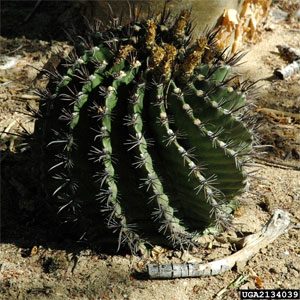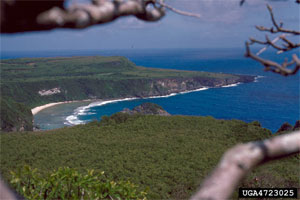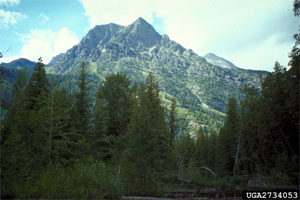|
Essentially temperature is a measure of average kinetic energy.
In general, the temperature of a location decreases with the distance from the equator.
Temperature increases are greatest in areas which receive the most solar radiation, such as areas in the tropical latitudes, high elevations, and where the air is most free from atmospheric impurities.
The temperatures at night time are regulated by the amount of heat absorbed and released by the earth’s surface.

William M. Ciesla, Forest Health Management International, www.forestryimages.org
As one moves up in elevation, temperatures generally decrease.
In the interior western US where air is not generally saturated with water vapor, an increase in 300 meters of elevation will result in a decrease of 2 degrees Celsius (Barnes et al. 1998).
However, as water vapor increases the change in temperature for a given elevation change will decrease.
Other landforms such as large bodies of water also play a large role in minimizing the range of temperatures found.
For example maritime climates often do not experience the same temperature ranges as continental climates.

Leonard Newell, USDA Forest Service, www.forestryimages.org
For the most part, vegetation changes with both latitude and altitude as a function of different temperature regimes.
This is apparent as one climbs to the top of a mountain peak. As you head up to the summit you will increase elevation, and with this you will see a change in the vegetation.
An example of the effects of elevation on vegetation changes is to drive from Phoenix Arizona to the San Francisco Peaks near Flagstaff Arizona.
When you begin your trip in Phoenix you will be in the Sonoran Desert, as you begin to climb up in elevation you will begin to see grasslands and then pinion and juniper forests.
After awhile you will see ponderosa pine forests, then mixed conifer, and then spruce/fir forests. Finally, after that you reach timber line, you will only see alpine tundra.

G. Keith Douce, The University of Georgia, www.forestryimages.org
Temperature also plays a key role in regulating plant activities.
In general plant activities will increase with temperature until some point and then begin to decrease until death occurs.
More Information:
Temperature
|
